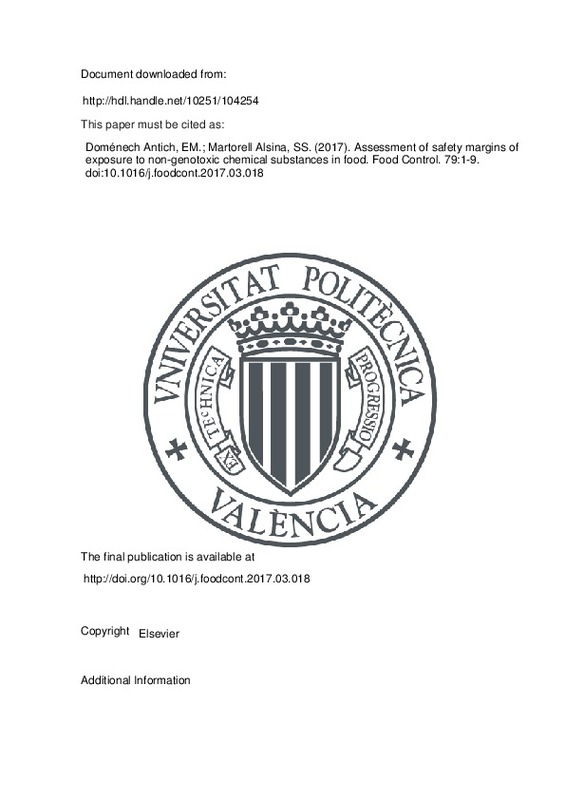JavaScript is disabled for your browser. Some features of this site may not work without it.
Buscar en RiuNet
Listar
Mi cuenta
Estadísticas
Ayuda RiuNet
Admin. UPV
Assessment of safety margins of exposure to non-genotoxic chemical substances in food
Mostrar el registro sencillo del ítem
Ficheros en el ítem
| dc.contributor.author | Doménech Antich, Eva Mª
|
es_ES |
| dc.contributor.author | Martorell Alsina, Sebastián Salvador
|
es_ES |
| dc.date.accessioned | 2018-06-18T04:25:53Z | |
| dc.date.available | 2018-06-18T04:25:53Z | |
| dc.date.issued | 2017 | es_ES |
| dc.identifier.issn | 0956-7135 | es_ES |
| dc.identifier.uri | http://hdl.handle.net/10251/104254 | |
| dc.description.abstract | [EN] The concept of Food Safety Margin (FSM) was introduced in microbiological risk analysis as an alternative approach to risk characterization within the informed-risk decision-making process. Its aim was to verify compliance with food safety objectives by assessing the effects of uncertainties. This paper describes the fundamentals and develop a new formulation of safety margins to verify compliance with food safety goals in relation to exposure to non-genotoxic chemical hazards. Both classical and probabilistic metrics were used to compare a given exposure to an estimated daily intake (EDI) with a given safety goal, the acceptable daily intake (ADI). The safety margins of these metrics were assessed in the exposure of peaches to organophosphorus pesticides. The pesticides considered were Azinphos-methyl, Chlorpyrifos, Diazinon, Dimethoate, Methamidophos, Parathion-methyl and Phosmet. The concentrations were obtained from the USDA pesticide database. The study period included the 11 years in which peaches were analysed from 1994 to 2014. The results show the importance of using the effect of uncertainty instead of mean values for risk characterization and that not only safety margins increased during this period but also that uncertainty was reduced. In general, large safety margins were observed in the period studied and few situations were found in which exposure was outside the safety limits. (C) 2017 Elsevier Ltd. All rights reserved. | es_ES |
| dc.language | Inglés | es_ES |
| dc.publisher | Elsevier | es_ES |
| dc.relation.ispartof | Food Control | es_ES |
| dc.rights | Reconocimiento - No comercial - Sin obra derivada (by-nc-nd) | es_ES |
| dc.subject | Daily intake | es_ES |
| dc.subject | EDI | es_ES |
| dc.subject | ADI | es_ES |
| dc.subject | Safety margin metrics | es_ES |
| dc.subject | Food | es_ES |
| dc.subject | Organophosphorus pesticides | es_ES |
| dc.subject | Peaches | es_ES |
| dc.subject | Risk assessment | es_ES |
| dc.subject | Risk characterization | es_ES |
| dc.subject | Risk-informed decision-making | es_ES |
| dc.subject.classification | INGENIERIA NUCLEAR | es_ES |
| dc.subject.classification | TECNOLOGIA DE ALIMENTOS | es_ES |
| dc.title | Assessment of safety margins of exposure to non-genotoxic chemical substances in food | es_ES |
| dc.type | Artículo | es_ES |
| dc.identifier.doi | 10.1016/j.foodcont.2017.03.018 | es_ES |
| dc.rights.accessRights | Abierto | es_ES |
| dc.date.embargoEndDate | 2018-09-01 | es_ES |
| dc.contributor.affiliation | Universitat Politècnica de València. Departamento de Ingeniería Química y Nuclear - Departament d'Enginyeria Química i Nuclear | es_ES |
| dc.contributor.affiliation | Universitat Politècnica de València. Departamento de Tecnología de Alimentos - Departament de Tecnologia d'Aliments | es_ES |
| dc.description.bibliographicCitation | Doménech Antich, EM.; Martorell Alsina, SS. (2017). Assessment of safety margins of exposure to non-genotoxic chemical substances in food. Food Control. 79:1-9. doi:10.1016/j.foodcont.2017.03.018 | es_ES |
| dc.description.accrualMethod | S | es_ES |
| dc.relation.publisherversion | http://doi.org/10.1016/j.foodcont.2017.03.018 | es_ES |
| dc.description.upvformatpinicio | 1 | es_ES |
| dc.description.upvformatpfin | 9 | es_ES |
| dc.type.version | info:eu-repo/semantics/publishedVersion | es_ES |
| dc.description.volume | 79 | es_ES |
| dc.relation.pasarela | S\337405 | es_ES |







![[Cerrado]](/themes/UPV/images/candado.png)

